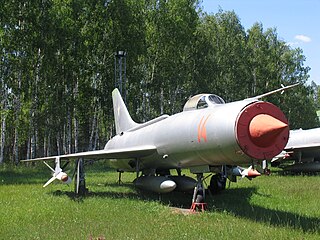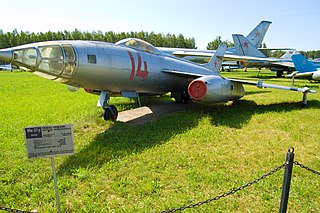Related Research Articles

The Yakovlev Yak-42 is a 100/120-seat three-engined mid-range passenger jet. It was the first airliner produced in the Soviet Union to be powered by modern high-bypass turbofan engines.

The Sukhoi Su-11 was an interceptor aircraft used by the Soviet Union in the 1960s.

The Yakovlev Yak-38 was the Soviet Naval Aviation's only operational VTOL strike fighter aircraft in addition to being its first operational carrier-based fixed-wing aircraft. It was developed specifically for, and served almost exclusively on, the Kiev-class aircraft carriers.

The Yakovlev Yak-141, also known as the Yak-41, is a Soviet supersonic vertical takeoff/landing (VTOL) fighter aircraft designed by Yakovlev. It was used for testing.

The Yakovlev Yak-36, also known as Izdeliye V, is a Soviet technology demonstrator for a VTOL combat aircraft.
The Yakovlev Yak-26, OKB designation Yakovlev 123, was a family of tactical supersonic bomber variants of the Soviet Yakovlev Yak-27 developed in 1956. It consisted of the Yak-123-1 and the Yak-26-3.

The Yakovlev Yak-27 was a family of Soviet supersonic aircraft developed in 1958 from the Yak-121 prototype. The most built variant was the tactical reconnaissance Yak-27R.

The Yakovlev Yak-19 was a prototype Soviet fighter built in late 1940s. It was the first Soviet aircraft to be equipped with an afterburning turbojet, the Klimov RD-10F that was derived from the German Jumo 004 engine. Only two examples were built as it was rejected for service by the Soviet Air Force.
The Yakovlev Yak-25 was a Soviet military aircraft, an early turbojet-powered fighter aircraft designed by the Yakovlev OKB. The designation was later reused for a different interceptor design. Tasked by the Council of Ministers in a directive issued on 11 March 1947, with producing a straight winged fighter similar to the earlier Yak-19, but powered by a Rolls-Royce Derwent V, OKB-115 swiftly produced the Yak-25, which blazed several trails as the first Soviet fighter with a fully pressurised cockpit, air conditioning, jettisonable canopy, and hydraulic airbrakes on the fuselage amongst other innovations.

The Yakovlev Yak-30 was an experimental Soviet interceptor from the late 1940s. Derived from the Yak-25, from which it differed primarily in having wings sweptback 35° at quarter chord, the Yak-30 retained the fuselage, tail surfaces and undercarriage of the earlier fighter.
The Sukhoi Su-10 or Izdeliye Ye was a Soviet turbojet-powered bomber aircraft built shortly after World War II.

Yakovlev Yak-50 was an early experimental turbojet interceptor aircraft designed in 1948 by the Yakovlev OKB in the USSR. The aircraft was essentially a stretched version of the Yakovlev Yak-30 (1948), with a more powerful engine and greater wing sweep. The Yak-50 is perhaps most significant as the first Yakovlev aircraft equipped with velosipednoye (bicycle) landing gear, a trademark of later Yakovlev designs. The Yak-50 designation was later reused for a propeller-driven aerobatic and trainer aircraft.

The Il-54 was a transonic bomber developed in the USSR in the 1950s. Only two examples were built before the project was abandoned.

The Lavochkin La-152,, and its variants, was a jet fighter prototype designed and manufactured by the Lavochkin Design Bureau (OKB) shortly after the end of World War II. Derived from the Lavochkin La-150, the 152 used several different engines, but the program was canceled as other fighters with more powerful engines and swept wings showed more promise.

The Yakovlev Yak-32 was a single-seat version of the Yakovlev Yak-30 (1960), and was claimed by the OKB to be the world's first sporting aircraft with an ejection seat. This version was designated Yak-104PS. Neither the Yak-30 nor the Yak-32 entered production.

The Yakovlev Yak-1000 was a Soviet supersonic technology demonstrator intended to evaluate the aerodynamic layout and field performance of the cropped delta wing discussed in captured German documents in combination with the new Lyulka AL-5 turbojet. The tandem undercarriage proved to be unsatisfactory and there were serious flight stability problems related to the delta wing, enough so that it never flew after an accident during taxiing tests.

The Yakovlev Yak-140 was a Soviet prototype lightweight supersonic fighter developed during the 1950s. The prototype was completed in 1954, but it was denied authorization to enter flight testing and the program was cancelled in 1956.
The Mikoyan-Gurevich I-75 was the final design of a series of three experimental swept-wing interceptors developed in the Soviet Union in the mid-late 1950s by the Mikoyan-Gurevich design bureau from their Mikoyan-Gurevich I-3 airframe. All the aircraft in the I-3 program were affected by delays in the development of the Klimov VK-3 turbojet engine, its cancellation and ultimate replacement by the Lyulka AL-7F turbojet engine.
The Mikoyan-Gurevich I-350, was a Soviet Cold War-era experimental fighter aircraft. It was the first Soviet aircraft able to maintain supersonic speed.
The Rybinsk RD-36-35 was a small lift turbojet engine, designed for use on V/STOL aircraft at the Rybinsk Engine Design Bureau (RKBM), designed by Pyotr A. Kolesov. Very little is known of this engine, probably due to confusion with the similarly designated Kolesov RD-36 and Lotarev D-36, which have little or no relation to the lift-jet.